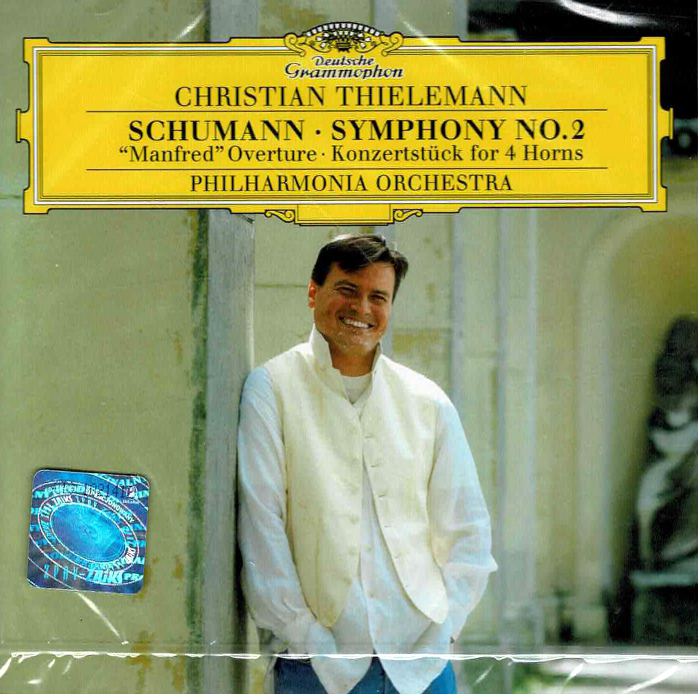Logowanie
Mikołaj - ten to ma gest!
Miles Davis, Horace Silver, Jay Jay Johnson, Percy Heath, Kenny Clarke, Lucky Thompson
Walkin'
20bit K2Super Coding - ale jak to brzmi!
Kasety magnetofonowe
Winylowy niezbędnik
ClearAudio
Double Matrix Professional - Sonic
najbardziej inteligentna i skuteczna pralka do płyt winylowych wszelkiego typu - całkowicie automatyczna
SCHUMANN, Christian Thielemann, Philharmonia Orchestra
Symphony No. 2 / Manfred Overture / Konzertstück for 4 Horns
I can’t remember when mind, heart and senses were so engaged by a Schumann orchestral disc: a disc that cares and dares in equal measure. To start with, it’s a programme of Schumann at his most daring, formally and instrumentally (it’s also brilliantly designed for continuous listening). Then there are the interpretations, obviously forged by a man of the theatre; one able to generate electric tensions in the studio, and one who cares deeply about the euphony and expressive potential of Schumann’s orchestration, in particular its moments of delicacy. Thielemann is also his own man, making no stylistic concessions to ‘historically informed’ performance. The disc begins with the Manfred Overture and a possible act of provocation: its opening three chords are very smoothly delivered (they are usually incisive and strong). “Beautifully weary” is the scarcely adequate description I wrote in my notes; and they are justified by the spacious gravity and dignity of what follows. If you are familiar with the restless momentum generated by, say, a Toscanini or a Munch (RCA, 10/61 – nla), then you may find this Manfred too ready to yield to introspective slower motion (a feature of the performance of the Second Symphony). Then Manfred’s interior world is blown away by “something quite curious” as Schumann described his Konzertstuck for four horns and orchestra. Replace “curious” with “dazzling”, even “reckless”, and you might gain a better idea of the piece, opening on this occasion with two very incisive chords, roistering horns from either side of the stage, and immediate lift-off. Here is playing of great brilliance and bravado, enlivening alertness and, in the central Romanze, a disarming sensitivity (a pity the horn quartet receives no credit in the booklet). I doubt we’ve had a performance of the Second Symphony as satisfying since Karajan’s and Sawallisch’s from the early 1970s. Though perhaps Bernstein might seem the more obvious parallel in the extremity of the tempo modification. On first hearing, I occasionally felt Thielemann had lost his sense of proportion, principally in the Scherzo, whose much slower Trios won’t avoid the charge of sounding self-conscious. But, more often than not, a few bars further on, and the nature of the expression released by that slower tempo makes clear the reason for its choice. And in the Symphony’s outer Allegros Thielemann always ensures enough urgent propulsion and springing energy to make workable his many slowings. Never do you feel the tension sagging as a result of a slowing; on the contrary, the contrasts invariably intensify the drama. The Symphony’s Adagio (over 12 minutes of it; Goodman is 8'20'' and ten minutes is the average) is the disc’s principal glory: a properly ‘inner’, wondrously sustained and shaped cantabile, with the essential bass-line well defined (not forgetting the rich infill of violas and horns). There is, of course, plenty of vibrato, and an especially beautiful oboe solo. No doubt it is all carefully planned and prepared, but not in the least calculated sounding. And herein seem to lie the seeds, perhaps the actual blooms, of so much German late romanticism. It might be thought a risky business recording Schumann in a church, but the microphones are close and this ample sound offers a convincing focus and proportion for all the workings of Schumann’s orchestra. First and second violins are separated either side of the conductor, and the woodwind are also widely spaced (some ten feet or so between flutes and oboes). Timpani are superbly defined.JS https://www.gramophone.co.uk/review/schumann-symphony-no-2manfred-overturekonzertst%C3%BCck































